Motorcycling in Japan I
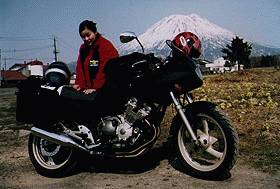
 Tohoku
Trip
Tohoku
Trip Tohoku
Trip Update
Tohoku
Trip Update Best
Places to Ride in Japan
Best
Places to Ride in Japan
 Worst
Places to Ride in Japan
Worst
Places to Ride in Japan When
to Visit Japan
When
to Visit Japan Stolen!
Stolen!
Notice
to Readers!
I left Japan in 1998, and have only
visited for short periods since then. When possible, I will update
this page with information when I become aware of it. It should
be noted, however, that information on this page may be out-of-date or
inaccurate. I am keeping this page up as long as I feel it might
be helpful. Any current information or corrections that readers may
be able to provide would be much appreciated.
Updated
September 2000
 Page 2: Where to Ride in Hokkaido, Where to Stay, Buying a Bike
in Japan, Things You Should Know, and Riding in Canada.
Page 2: Where to Ride in Hokkaido, Where to Stay, Buying a Bike
in Japan, Things You Should Know, and Riding in Canada.
Our
Spring 1996 Trip in Southern Hokkaido
In
the annals of motorcycle riding fiascoes, this has to rank right up there.
Okay,
so it wasn't a complete disaster.... we didn't crash and no one got hurt.
But in terms of sheer misery, money wasted and level of futility, this
is the only motorcycling experience I had that rivaled the ill-fated Himeji
motocross park incident of 1990, (where I jumped my rental RM125 into a
track-side pond after five minutes of riding at $100 an hour and couldn't
get the bike started again).
From out home in Sapporo, we planned our
trip for Golden Week, (end of April). We had made similar trips in
the Kansai region around this time, and although it was chilly at times,
it was always a lot of fun. We were going to go across the sea into
Northern Tohoku at first, but then we thought it would be too cold, (Northern
Tohoku is the area immediately under Hokkaido). So we decided to take a
ferry down south to Kansai, until we realized that that was going to cost
us ¥50,000 (Check
today's exchange rate.) in ferry fees alone. So we decided that it
wouldn't be that cold after all, ("Yeah, that's it! It'll be warm!! Yeah!!")
and planned a wacky route from Sapporo, down south a bit, and into Tohoku.
Well, the first day was okay, a bit cold, but not bad. Some of the roads
in the mountains were still closed due to snow, and some other roads were
surrounded by snow, but we had no major problems.
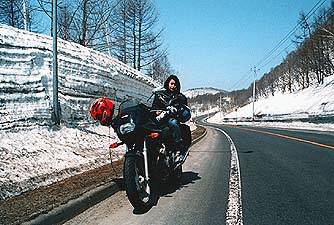
The second day traveling
along the coast got cold. Bitterly, bone-chilling cold. When we arrived
at the minshuku, wearing everything we owned, it started to rain. We were
the only guests. "We don't get many visitors at this time of the
year," said the proprietor, eyeing us as one would a streaker standing
at the gun counter at Wal-Mart.
The next day when
we woke up it was pouring, and even colder. We decided to cancel
the rest of the trip and head home, 280 kms away. It was without a doubt
the most miserable motorcycling experience I have ever had. We rode along
the coast for about 100 kms with a cruel cruel wind whipping off the water
from Siberia at about 5 Celsius, and the rain pouring down. We blundered
through ugly, boring fishing villages for what felt like years. My
hands froze solid, and we still had five hours of riding ahead of us. I
was frozen and miserable. We headed inland to escape the wind and
damp, and started climbing higher. The wind died down but the rain continued
and it got colder as we climbed into the snowy mountains. Then I felt an
icy chill in my nether regions. My new rainsuit sprung a leak in the crotch
area, and 4C water was seeping in. I started fantasizing about Mr Donut's
coffee and donuts, and even started envying the tourists trapped in the
buses. Thank God I had plastic bags on my feet under my boots. (Man, I
must have had a plastic bag over my head when I was planning this trip.)
I longed for the warmth of home and the marvelous Washlette.
Oh well, we learned
a very valuable lesson. Motorcycling season in Hokkaido does not start
in late April. If there is snow on the mountains that you can reach up
and touch from the street, it is too early. At least we were smart enough
to call off the trip before we had flushed a thousand bucks down the hole.
Tohoku
Trip Update
Well, I tried the
trip again in early August, and for the most part, it was a success. The
trip definitely started out slow, but picked up towards the end. Had three
days of sun, and only two of rain. Took the ferry from Tomakomai
in Hokkaido to Hachinohe in Tohoku (northern part
of Honshu the main island,) and spent the night in a YH. The next
day it rained as I rode to Morioka. I was a little disappointed
with Morioka, I don't think it's worth going out of your way to visit.
Stayed the night at Hachimantai YH, definitely one of the poorer
YHs I've visited. Damp, smelly, dirty, and poor food. The next day it looked
bad, lots of fog, light drizzle. However, after riding for about ten minutes,
the clouds suddenly broke and I was treated to great riding on a really
windy road. Rode to Kakunodate, which has an interesting old Samurai
quarter, but not much else. Spent the night on the Oga peninsula, which
was also disappointing. Oga city is a depressing dingy "resort"
town dedicated to flogging souvenirs and its many health spas, reeking
of sulfurous water. Yikes, no thanks. The trip didn't look too promising
at this point.
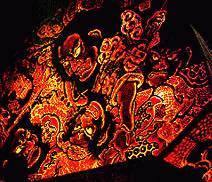
Neputa float lit
from within and carried by about a dozen men. There were about 50 of these
floats in total.
From here things picked
up. Rode out to Hirosaki, and saw the gorgeous Neputa Matsuri,
the most interesting festival I have ever seen in Japan. Next day I headed
out for the Shimokita Peninsula, (the axe shaped tip of Northern
Honshu). Made one teensy route error and ended up on an 80km gravel road
that was either always going straight up or straight down. If it had been
paved it would have been an amazing road, but riding it on a street-tired
bike it made for a slightly hairy but interesting ride. The ride up the
"blade" of the peninsula was uneventful, but the roads on the peninsula
were fantastic, some of the best I have ever ridden. Particularly Route
338 on the west coast, which had a gorgeous stretch of brand-new two-laned
blacktop, almost completely deserted, which wound through some beautiful
mountain and ocean-side scenery. See the picture at the bottom of
this page.
Also visited Mount
Sore-zan, a creepy ancient volcano dome containing a shrine to the
souls of dead children. Here you can find hundreds of children's pinwheels
spinning silently in the breeze, placed there by grieving family members,
trying to placate the souls of their kin and help them on the way to salvation.
Finally spent the
night at the Shiriyazaki YH, which was very nice. Woke early to
see the sunrise with the other guests at the YH, and we shared the event
with a herd of tame free-grazing horses. Returned that afternoon on the
Ohata - Muroran ferry. Total cost for the trip was about ¥45,000.
Recommended
Areas

Japan is, surprisingly,
a great place to ride, once you get out of the cities. I lived near Kobe
for about two and a half years, so this is the area I know best. I have
never toured the Kanto region, (around Tokyo), but even going
within 500 kms of Tokyo gives me the willies. Naturally, I can't comment
on the riding in that area. If you come to Japan, here is what I recommend,
from the areas in which I've ridden.
Kyoto
- Nara - Kobe - Himeji Area : Kansai
This area is by far the best bang for the
buck in Japan. Kyoto is unsurpassed in tradition and culture, and
with Nara and Himeji close-by, you can see a lot without
putting hundreds of kilometers on your bike. The side roads are windy and
uncrowded (usually), and a trip to the Sea of Japan or the Japanese
Alps is also possible. Also highly recommended is a trip to Takayama,
a gorgeous mountain town near the Japanese Alps.
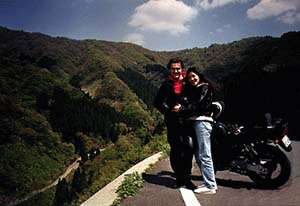
Robert and Emi near Takayama with their
rented CB400, around May 1994.
Shikoku
- Japan's Other Island
If you want to do a lot of riding, and see
a part of Japan that even a lot of Japanese have never seen, try Shikoku,
especially the southern parts. There are some incredibly winding and uncrowded
roads, and I still have great memories of the small-intestine shaped Route
439 through central Shikoku. (I once had a Japanese rider tell me he preferred
Hokkaido to Shikoku because Shikokou was "too winding.") It was a peg-dragging
white knuckle ride through gorgeous mountains and pretty villages. Rail
service in Shikoku is slow and not comprehensive, so riding is the only
way to go. Shikoku is still considered quite backwards, and there are some
really gorgeous unspoiled areas here. I've toured Shikoku twice, once on
an NS250, and once on an NS400, and I'd go back in a flash. Avoid the big
cities near the mainland, and you'll love it.
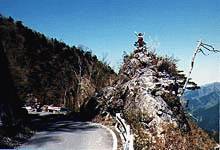
Yoshiko checks out the view from a
hairpin turn in Shikoku.
Okayama
- Chugoku
This area, approximately including Hiroshima
and Okayama city, has some gorgeous unspoiled mountain roads. In
Okayama
there are also about six International Villas, which offer great
lodgings, cheap prices, and beautiful scenery. These villas are available
only to foreigners, and the prices are dirt-cheap. (If you really want
the address for the Int'l Villa Association, Email me and I'll send it.
They are so good though I should actually keep it a secret). My absolute
favorite places in Japan would have to be Fukiya and Bitchu Takahashi
(which has the castle at the highest elevation in all of Japan), gorgeous
villages that are like a trip back in time. The Sea of Japan is
also relatively unspoiled and untouristed. I've made trips in this area
on both NS250 and 400, as well as an old Yamaha TT250, (two-up, youch!!).
Kyushu
- Southern Japan
I've got to admit, my experiences here have
been very brief, but from what I did see, it would be worth it to go back.
The coastline was for the most part clean and the roads windy, and the
weather great. I made this trip on my NS250, after taking a ferry from
Kobe to Miyazaki.
Where
Not
to Go!!
You really want to avoid spending any amount
of time in any big city. Visiting Tokyo, Osaka, Kobe or even Kyoto
is best done using local transportation. It is much easier, faster and
less nerve-racking. Of course, you can always just park your bike while
visiting these places. Japan is quite a small country, so you can't avoid
driving through some big cities at some point. Even small little "country"
towns can be highly developed and congested. A lot of Japanese talk about
Hokkaidoas
if it was a motorcycle paradise. I guess for the Japanese it is pretty
interesting: wider, straighter roads, broad plains, more national parks,
camping and hiking opportunities. But for the foreign tourist, it's nothing
to get too excited about in my mind. There are no great cultural attractions,
the roads aren't as winding, and the season is very short. I would personally
give it a miss, especially considering the expense of getting there.
When to Go
Note: The seasons I am talking about can
be longer or shorter depending on which end of Japan you're talking about:
I'll be referring to the seasons in the Tokyo - Osaka - Hiroshima corridor.
The best times to ride in Japan are in
Autumn or Spring. Summer, including June, July, August and September
in most of the country, is very hot and humid, (except Hokkaido, which
has a pleasant summer).
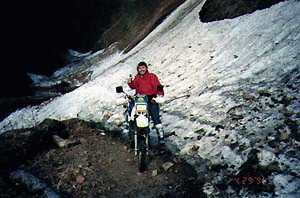
Mountain
roads can be snowed-in until early summer.
We
helped this guy across this snowfall on a road in the Japanese alps, but
we decided to head back
as
our street bikes would have slipped down the gorge, possibly making us
inconveniencing and embarrassing the rental shop owners.
Winter in Japan runs from about November
to the end of March. Snow falls in the mountains and on the Japan-sea side.
Definitely not riding weather, although daytime highs are almost always
above zero. April can also be quite cold, but May is usually a nice time
to ride. The cherry blossoms start blooming, and much of the countryside
is covered in pink flowers. This season extends into June, depending on
the area. June sees the arrival of the rainy season, (except Hokkaido,
which has no rainy season), which is not too pleasant, as it is not only
raining a lot, it can also be quite hot. You will also want to avoid the
first week in May as almost everyone in Japan gets "Golden Week" holidays,
and a lot of the roads will be very crowded. Summer, as I explained, is
very hot and humid, but not totally unbearable. Riding in the city with
a full-faired bike is pure hell, as I found out one very hot day in August
in Osaka a few years ago. The third week in August is the time of
the Obon festival, and things will be crowded, as almost everyone
in Japan is on holiday. Getting into mid-to-late September and most of
October, you will find the best riding. Days are pleasantly warm, there's
no rain, and the leaves are changing color. Beaches will be uncrowded,
and tourist season is winding down. My recommendation.

Route 338 in Tohoku.
Brand-new pavement, totally deserted.
Stolen!
When I arrived in Japan
in 1989, I used to leave my helmet on my motorcycle handlebars all day,
unlocked, and more importantly, unstolen when I got back. Back in
1989, I thought I owned the only u-lock in Japan. I found out in the summer
of 1997 why Japanese are so security-concious now.
One morning I grabbed
my helmet and headed out the door on my way to work. The day looked nice
and I was reassured by the familiarity of my neighborhood as I walked down
the stairs to the parking lot: the never-ending construction of the apartment
across the street, the constantly-being-replenished heap-'o-trash on the
corner, one million crows perched on a high-tension wire, the neighborhood
tree, and the brick I rest my sidestand on. My eyes followed the side of
the brick upwards, towards where my bike usually sits, but came to a halt
at the top of the brick. My trained eye noticed that the space normally
occupied by my motorcycle, by all objective standards, was empty!
I did not dwell on
the aesthetic quality of the brick too long, perhaps a minute or two, just
long enough for the construction workers across the street to admire the
pathetic sight of a gaijin holding a helmet and staring at a red brick
and an oil stain. Gone. Stolen. Vanished. I ran back inside, and called
the cops. They showed up about ten minutes later, inspected the scene of
the crime, drew a few diagrams, sucked in a lot of air, and had us come
down to the station to fill out a report.
The police were very
friendly, telling us that the bike might be found, but if it was, it might
come back to me in a box. Unlike North America, where bikes are stolen
for parts and stripped, bikes here are stolen by teenage "Yankees" as they're
called to use for joyrides. These brats take the bikes, cut off the mufflers,
add some ludicrous accessories, (whale-tails are big, as are huge girder
like contraptions holding the headlight), and then go out late at night,
often two-up and helmetless, and ride the bike as slowly as possible through
intersections, all the while revving the bike as high as it will go, thus
attracting as much attention as possible.
I was lucky. The police
found my bike in Otaru, a city about 60kms from Sapporo,
abandoned in a tunnel when it ran out of gas. The damage was light,
only the ignition key cylinder and tank lock had to be replaced, at a cost
of about $240. I also spent another $150 on new locks and an alarm. I also
covered the bike in stickers that say "Alarm installed." I was lucky. Later
that summer, a coworker had his brand-new Kawasaki Zephyr
stolen from right in front of our office downtown, and it too had the forks
locked and a disc brake shackle in the front wheel. And he still owes $5000
on the loan...

Next Page
To Top
Copyright© 2000, Sean Lewkiw
URL: https://members.tripod.com/~sean_lewkiw/

![]() Tohoku
Trip
Tohoku
Trip![]() Tohoku
Trip Update
Tohoku
Trip Update![]() Best
Places to Ride in Japan
Best
Places to Ride in Japan
![]() Worst
Places to Ride in Japan
Worst
Places to Ride in Japan![]() When
to Visit Japan
When
to Visit Japan![]() Stolen!
Stolen!
![]() Page 2: Where to Ride in Hokkaido, Where to Stay, Buying a Bike
in Japan, Things You Should Know, and Riding in Canada.
Page 2: Where to Ride in Hokkaido, Where to Stay, Buying a Bike
in Japan, Things You Should Know, and Riding in Canada.






